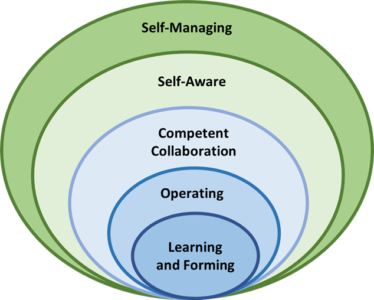Agile celebrates the team. This is explicit in the Agile Manifesto and Scrum. Implicitly Agile also harmonizes with the celebration of individual creativity, as captured by Daniel Pink, Synek and others. A creative group is a wonderful thing.
The base model we still often use to talk about team development is Dr. Tuckman’s model: Forming, Storming, Norming, Performing – and some now like to add Adjourning.
Dr. Tuckman wrote this model in 1965, over 55 years ago. I wonder if he’d mind us taking another look.
An often-seen graph of the Tuckman model and team effectiveness by phases is shown below. Basically, in the forming phase people are just getting oriented, getting the lay of the land; in storming they start to move into more intentional action; they go through inevitable collisions and realignment until they smooth into norming and on to performing. I think Dr. Tuckman would forgive me that simplification for the sake of discussion. And it supports this point: People can relate to this model. It’s familiar, it is basically simple; they see it every day. They’ve experienced. Being able to identify what you’re experiencing is always orienting.
Tuckman’s Team Development Model

But is this, or should this be, the main plot? I think not, or at least not any more. I suggest that the plot, the story, of any great team, in any industry or endeavor, at any time, is so much more than getting oriented to each other, sorting out roles, and getting on with it. Alignment on purpose, growth mindsets, the desire to both be creative and to help, these things seed stories that inspire us on an almost daily basis and are what can and do cause us, when we are at our best, to help each other maximize our contributions.
This is where I see the best elements of agile and organizational development trending. And with thanks to Dr. Tuckman for starting the conversation and getting us to look, I think it’s time for us to improve our minimum view of how teams produce together with choice.
In our workshops, we have taken a step in this direction. (We are firm believers in George Box’s famous statement that “All models are wrong, but some are useful.”)
With fairness to Dr. Tuckman, I should describe it as simply as possible: Any team when they get together need some orientation to what they’re up to, who can do what, and what collectively they need to get up to speed on. If they are purpose driven, they are intentional about moving into operation quickly and learning rapidly how to do so with less friction. They quickly or gradually achieve an organic awareness of themselves as a group, a living thing and, with further purpose will move into self-management.

In our workshops, we find this more granular, intentional model helpful in exploring team coaching.
We even hope that Longfellow might approve of our attempt to make it at least a little goal and action oriented. As he said:
Life is real! Life is earnest! …
Lives of great men all remind us
We can make our lives sublime,
And, departing, leave behind us
Footprints on the sands of time;
Footprints, that perhaps another,
Sailing o’er life’s solemn main,
A forlorn and shipwrecked brother,
Seeing, shall take heart again.
Let us, then, be up and doing,
With a heart for any fate;
Still achieving, still pursuing
Learn to labor and to wait.
A Psalm of Life, Henry Wadsworth Longfellow
But what do you think? We’d love to hear from you.
*[We cover this team development model in our ICAgile Agile Certified Coaching workshop. Check us out at www.clearsystemsllc.com/training. ]

